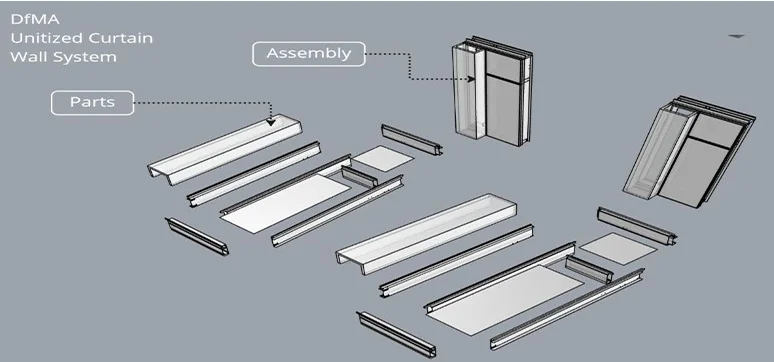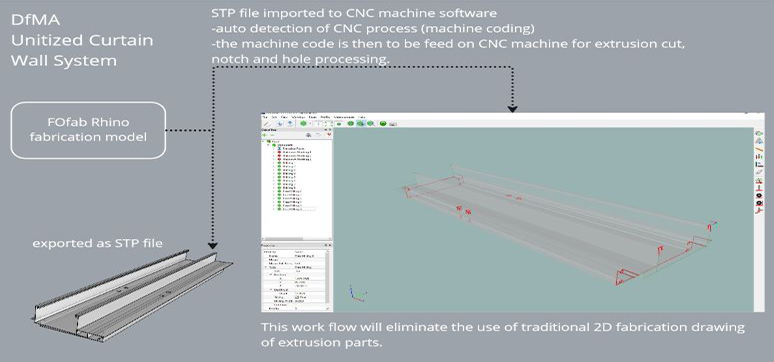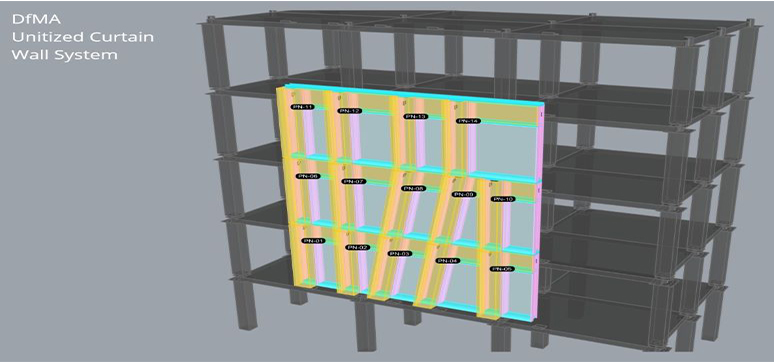Over the past few decades, façade design has witnessed a paradigm shift with the advent of innovative methodologies, and one such approach is Design for Manufacture and Assembly (DfMA). With 16 years of hands-on experience in façade design, engineering, testing, and inspection, this article aims to explore the significance of DfMA in the context of façade architecture, shedding light on its advantages and impact on the industry.
Having spent more than a decade and a half immersed in the intricacies of façade design, engineering, testing, and inspection, I have witnessed firsthand the evolution of industry practices. The challenges posed by complex architectural visions, stringent performance requirements, and the need for sustainable solutions have spurred the exploration of innovative methodologies such as DfMA.
Understanding DfMA Façades
DfMA is a methodology that focuses on optimising the design process by integrating manufacturing and assembly considerations early in the design phase. In façade design, this approach holds immense potential for streamlining the construction process, enhancing efficiency, and ensuring a higher level of quality in the final product.
Efficiency Through Integration
One of the primary advantages of DfMA in façade design is the seamless integration of manufacturing and assembly considerations from the early stages of the design process. Traditional approaches often involve a sequential progression from design to manufacturing and finally to assembly, leading to potential inefficiencies and rework. DfMA, on the other hand, encourages collaboration between designers, engineers, and manufacturers right from the outset.
This integrated approach allows for a more holistic understanding of the project, fostering better communication and coordination among stakeholders. By identifying potential manufacturing and assembly challenges early in the design phase, the likelihood of costly revisions and delays is significantly reduced.
Precision Engineering
Over the years in façade engineering, I have come to appreciate the precision required to meet the demanding performance criteria of modern architectural façades. DfMA facilitates a more meticulous engineering process by considering manufacturing constraints and assembly requirements upfront. This ensures that the final product aligns seamlessly with the intended design while meeting performance standards.
Furthermore, DfMA enables the use of advanced technologies such as parametric modeling and digital simulation to refine and optimise the design iteratively. This iterative process allows for continuous improvement, leading to façades that not only meet but often exceed performance expectations.
Testing and Inspection: Ensuring Quality Assurance
The façade testing and inspection have instilled in me a deep appreciation for the critical role these processes play in delivering high-quality façades. DfMA, by virtue of its integrated approach, contributes significantly to quality assurance by addressing potential issues before they manifest in the physical construction.
Through virtual simulations and prototyping, DfMA allows for thorough testing of the façade’s performance and constructibility. This proactive approach minimises the likelihood of post-construction issues, reducing the need for costly retrofitting and ensuring that the façade functions as intended from day one.
Sustainable Solutions
In the current architectural landscape, sustainability is a non-negotiable aspect of any design. DfMA in façade design aligns seamlessly with sustainability goals by minimising material waste, optimising energy efficiency, and reducing the overall environmental impact of construction.
By considering the entire lifecycle of the façade – from manufacturing to assembly to eventual dismantling – DfMA facilitates the development of sustainable solutions. This approach can be essential in meeting the growing demand for environmentally conscious architecture and aligns with global efforts to reduce the carbon footprint of the construction industry.
Conclusion
As I reflect on my years of experience in façade design, engineering, testing, and inspection, the adoption of DfMA emerges as valuable in the industry. The integration of manufacturing and assembly considerations from the inception of a project has the potential to revolutionize the way we approach façade design, fostering efficiency, precision, and sustainability. The journey from conceptualizing a façade to its realisation is intricate, and DfMA provides a roadmap for navigating this complexity with finesse. As the industry continues to evolve, embracing methodologies that enhance collaboration, optimise processes, and deliver high-quality, sustainable solutions becomes paramount. DfMA, with its holistic approach, stands as a testament to the evolution of façade design, ensuring that our architectural visions are not only realised but also endure the test of time with excellence.
















